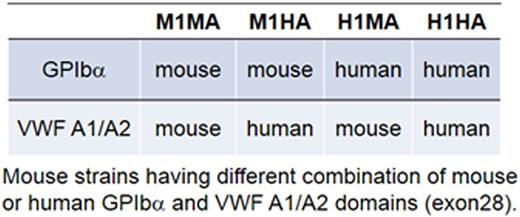Abstract
Introduction: The interaction between von Willebrand Factor (VWF) and platelet glycoprotein (GP) Ibα is key for initiating the response to vascular injury that leads to hemostasis or, in pathological conditions, may be a cause of thrombosis. VWF binding to GPIbα occurs through the A1 domain (VWFA1) and its role in platelet adhesion and aggregation becomes progressively more important with increasing shear rates, i.e., in arterioles or pathologically stenosed arteries. Owing to the key role in platelet adhesion/aggregation under arterial flow conditions, VWFA1 has been considered an obvious target for antithrombotic intervention. However, efforts to develop this concept have been complicated by the lack of suitable animal models due to species-specificity in VWFA1-GPIb binding. To obviate the problem, we have generated new mouse strains with humanized VWF-GPIb interaction and characterized the resulting phenotypes in experimental ex vivo and in vivo models of hemostasis and thrombosis.
Methods: In the human VWF gene, and in the mouse Vwf ortholog, exon 28 encodes domains A1 and A2, including the VWFA1 GPIb-binding site. We generated a knock-in mouse by targeted insertion of human VWF exon 28 (VWFh28) into the mouse Vwf exon28 locus such that mouse platelet GPIbα (M1) interacted with mouse VWF containing human A1 domain (HA); the strain was designated M1HA (Table). These mice were cross-bred with the previously described transgenic strain (mGPIbαnull;hIbαTg) in which human GPIbα is expressed on the platelet surface in the context of the mouse GPIb-IX-V complex (strain designation: H1MA). The resulting strain was thus designated H1HA, with humanized GPIb-VWF interaction. The unmodified wild type mouse strain used for reference was designated M1MA (Table). All mouse strains were in C57BL/6 genetic background. VWF plasma concentration was measured by ELISA and function ex vivo was evaluated by ristocetin-induced platelet aggregation. In vivo, we measured the tail bleeding time to gauge hemostatic efficiency as well as the propensity to support pathological thrombosis in the carotid artery injured by exposure to ferric chloride.
Results: Plasma of VWFh28 mice expressing mouse or human platelet GPIbα had VWF levels (M1HA: 876.4 ± 209.5 mU/ml, n = 16; H1HA: 848.9 ± 121.0 mU/ml, n = 15) not significantly different from wild type mice (M1MA: 1022 ± 267.4 mU/ml, n = 23). Addition of 1.5 mg/ml ristocetin into platelet-rich plasma (PRP) from M1MA, M1HA and H1MA mice elicited no response; only in PRP of H1HA mice did ristocetin cause platelet aggregation that, as in human PRP, was inhibited by the anti-human VWFA1 monoclonal antibody, NMC-4. The tail bleeding time was abnormally prolonged in the M1HA strain expressing human VWFA1/mouse GPIbα, but normal in the H1HA strain expressing human VWFA1/human GPIbα (6.0 ± 3.8 min vs. 1.5 ± 0.9 min; n = 12); the latter was similar to the bleeding time in the M1MA strain (1.0 ± 0.1 min, n = 10). Thrombus formation (time to occlusion) following a carotid artery injury with 9% FeCl3∙6H2O was greatly delayed in the M1HA strain (1760.0 ± 538.5 s, n = 6) but similar to WT M1MA in the H1HA strain (485.2 ± 63.7 s vs. 598.3 ± 84.0 s, n = 6, respectively).
Conclusions: Knock-in of human VWF exon 28 into the mouse Vwf locus led to successful biosynthesis of chimeric mouse-human VWF protein in vivo under endogenous promoter control, maintaining normal physiologic expression in endothelial cells and megakaryocytes/platelets. Tail bleeding time and in vivo thrombosis assays confirmed the normal functional interaction of mouse VWF containing human A1 domain with hGPIbα. Moreover, the normal response to ristocetin with platelet aggregation, and inhibition of the latter by the specific NMC4 antibody, indicates that the "humanized" H1HA mouse strain could be a powerful tool to select and develop new interventions for the diagnosis and treatment of hemostatic and thrombotic disorders.
No relevant conflicts of interest to declare.
Author notes
Asterisk with author names denotes non-ASH members.


This feature is available to Subscribers Only
Sign In or Create an Account Close Modal